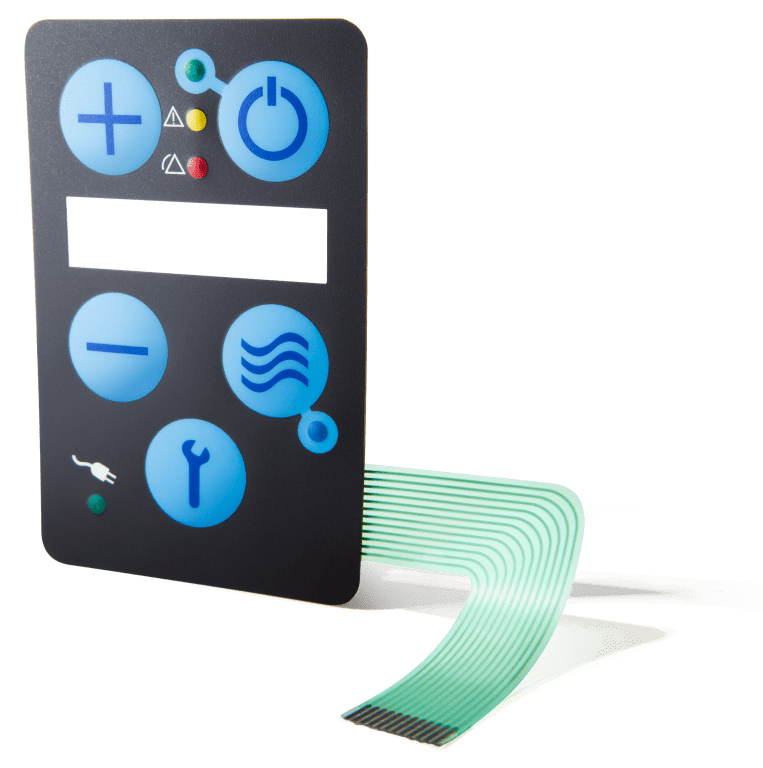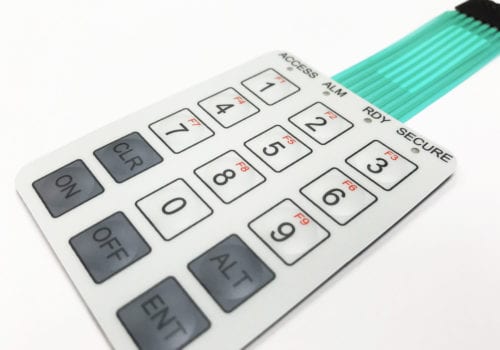Recognizing the Relevance of Membrane Switches in Individual Interfaces
Membrane buttons are important parts in the style of reliable interface, promoting not only performance however also boosting visual appeal and individual interaction. Their distinct features, such as resistance to adjustable designs and ecological factors, make them ideal for a diverse variety of applications throughout several sectors. As we explore the future patterns and numerous advantages related to Membrane technology, it comes to be clear that these buttons are greater than simply parts; they represent a convergence of technology and practicality. The ramifications of this modern technology on user experience are worth checking out even more.
What Are Membrane Switches?

The spacer layer, which has sticky residential properties, permits the separation of the circuit layer from the overlay, making sure that the switch remains in a non-activated state until pushed. When pressure is put on the overlay, it presses the spacer layer, connecting the gap and finishing the circuit in the underlying layer. This style not just minimizes the physical space needed for typical mechanical switches but also improves the sturdiness of the device, as Membrane buttons are normally immune to dust, wetness, and other ecological elements.
Frequently found in applications varying from consumer electronics to clinical devices, Membrane buttons are indispensable to modern-day innovation, offering a efficient and straightforward interface that straightens with contemporary style requirements.
Advantages of Membrane Switches
While many button innovations exist, Membrane Switches offer distinctive advantages that make them especially preferable in various applications. One of the key benefits of Membrane buttons is their compact style, which permits for space-saving implementations in gadgets where actual estate is limited. Their slim profile not just enhances aesthetic allure but likewise promotes lightweight building.
An additional considerable benefit is their resistance to environmental elements. Membrane buttons are typically sealed versus dampness, dirt, and contaminants, making them optimal for use sought after settings, such as clinical tools and industrial equipment. This toughness expands the life-span of the switch, reducing maintenance costs and improving integrity.
In addition, Membrane buttons can be tailored to meet specific design requirements, incorporating distinct graphics and shades that enhance user interaction. Their tactile feedback options can also be customized to give a satisfying user experience. In addition, Membrane switches are economical, especially in high-volume applications, as they can be created effectively.
Applications in Various Industries

In the consumer electronic devices industry, Membrane buttons are common in devices such as microwaves, cleaning devices, and remotes. Their tactile feedback and visual options improve user experience while offering a smooth, modern-day look. Additionally, vehicle producers make use of Membrane buttons in control panel controls and infotainment systems, where room is limited, and customer engagement is essential.
Furthermore, the commercial industry leverages Membrane switches in control panels for machinery and tools, allowing for instinctive operation in typically rough atmospheres. Their resistance to chemicals and dampness ensures durability and integrity in these applications. In general, the flexibility of Membrane Switches contributes dramatically to their widespread use, making them crucial in various technical domain names.
Design Factors To Consider for Membrane Switches

When making Membrane switches, several essential considerations must be thought about to make sure optimum capability and user experience. Firstly, the choice of materials is vital; choosing long lasting, high-grade substratums can boost the switch's durability and resistance to environmental elements such as wetness and temperature fluctuations.
Second of all, the style of the graphic overlay should focus on quality and simplicity of use. Icons and message have to be readable, and the design ought to help with intuitive communication (membrane switches). Furthermore, tactile feedback is crucial; including a tactile dome or other devices can enhance the user experience by giving physical verification of activation
Another vital aspect is the switch's electric efficiency. Designers have to make sure that the conductive traces are properly made to minimize resistance and stay clear of signal interference. This entails examining the required actuation pressure and guaranteeing compatibility with the digital elements they will certainly interface with.

Future Patterns in Membrane Innovation
As innovation remains to advancement, Membrane buttons are poised to progress dramatically, driven by advancements in products and manufacturing strategies. One arising trend is the unification of innovative materials, such as conductive inks and versatile substratums, which improve durability and decrease the total weight of Membrane switches. These materials not only enhance the responsive response but additionally enable the layout article source of switches that can stand up to harsher ecological problems.
Furthermore, the combination of touch-sensitive modern technologies is changing traditional Membrane Switches into more interactive interface. Capacitive touch sensors embedded within Membrane switch panels can offer a much more receptive and instinctive customer experience, straightening with the expanding need for streamlined, modern-day designs in consumer electronics.
Additionally, advancements in printing techniques, such as digital and 3D printing, enable rapid prototyping and customization of Membrane buttons. This adaptability permits suppliers to react faster to market needs and consumer choices.
Last but not least, sustainability is coming to be a substantial emphasis, with makers checking out environment-friendly materials and processes. As these fads unravel, the future of Membrane technology promises boosted capability, visual appeal, and ecological obligation, solidifying their role in innovative interface across various sectors.
Final Thought
Finally, Membrane Switches represent a vital part in the style of interface, combining functionality with visual versatility. Their advantages, consisting of sturdiness and resistance to environmental variables, make them appropriate for diverse applications throughout various sectors. Moreover, thoughtful design factors to consider improve user interaction and experience. As innovations in technology proceed, the evolution of Membrane switches is anticipated to further fine-tune user interfaces, driving advancement and improving functionality in a progressively complex technical landscape.
Membrane switches are essential elements in the layout of effective user interfaces, facilitating not just capability yet also improving aesthetic allure and customer interaction.Membrane Switches serve as an get more important element in numerous customer interfaces, facilitating a seamless communication in between customers and electronic devices.While various switch innovations exist, Membrane Switches offer unique advantages that make them especially preferable in different applications.Additionally, Membrane buttons can be customized to meet particular design requirements, incorporating distinct graphics find out and colors that enhance user interaction.In conclusion, Membrane Switches stand for a crucial element in the style of individual interfaces, integrating performance with aesthetic flexibility.